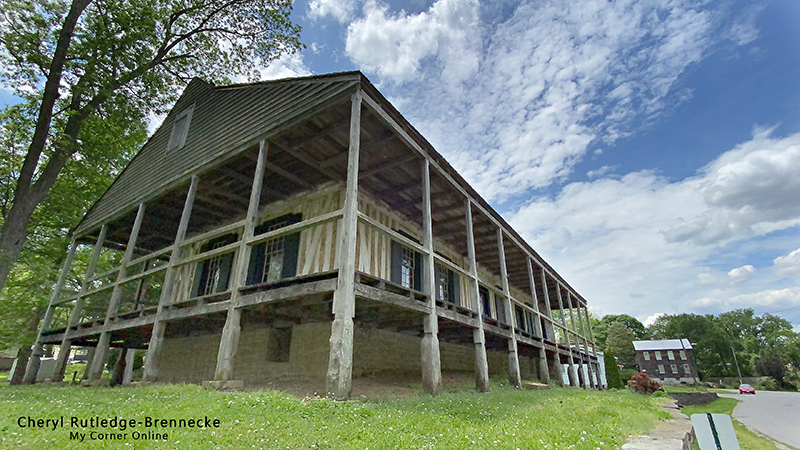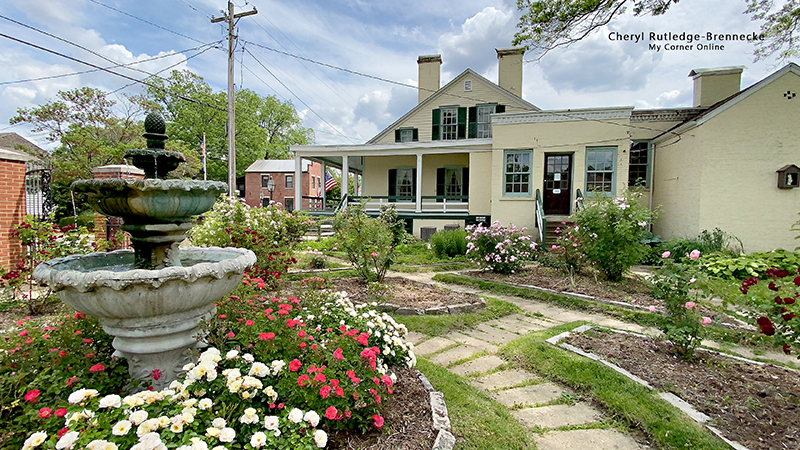My Corner Online
Historic Ste. Genevieve
THIS IS A WORKING PAGE, PLEASE DO NOT COPY.
When considering how to set up this page, I decided for my purposes it is best put in chronolical order of when the homes were built so that I can place my ancestors into the big picture from when they lived in Old Ste. Genevieve and Ste. Genevieve. I include the numbers on the houses from the map given at the Welcome Center (as seen at the beginning of each video) so that when you visit Historic Ste. Genevieve you can follow along.
When touring the homes in historic Ste. Genevieve, a common theme taught is that the buildings are made with vertical logs, some of which are put into holes deep into the ground (poteaux en terre) and other posts that are put on top of a sill (think window sill that is a shelf of wood or stone that the window frame sets on) (Poteaux-sur-sol). The vertical posts set on top of the concrete or stone sill. There are only 5 poteaux en terre building that survive in North America. Three are in Ste. Genevieve (Beauvais-Amoureux House, Bolduc House, and Guibourd-Valle House). The other two are the Badin-Roque House in Natchitoches, Lousiana, and the La Pointe-Krebs House in Pascaqoula, Mississippi. The significance of the "poteaux en terre" (post in the earth) is that the wood is subject to decay being in the ground being exposed to elements like termites and water.
Ste. Genevieve Welcome Center
66 South Main Street, Ste. Genevieve, MO 63670 (i on map, for "information" I suppose)
The Ste. Genevieve Welcome Center is a great place to start when visiting Ste. Gen. It is jointly operated by the City and the National Park Service. Since the National Park Service began acquiring building in 2020 and working on their own set up of these historic buildings, they have begun moving many of the displays and original pieces to this building. The staff is extremely helpful in guiding you to start your day. Ste. Geneviève National Historical Park was established as a unit of the National Park Service on October 30, 2020. In 2021 when I recorded these videos, not all of the buildings were owned by NPS. Some were in the process of being aquired. Others will retain other ownership. Regardless, I am thankful to all of the owners, and prior owners, who have worked hard to preserve our heritage. To credit them for their work, I am bolding their names on this page. Also worthy of mention is the Colonial Dames of America in the State of Missouri which owned and restored many of these building and offered tours of them for many years.
1780's and Prior
There is much debate on the date of the founding of Old Ste. Genevieve. I have read the reasons and documents found that support each theory in books. Regardless, the first census was in 1752 and my ancestors were there. For perspective, Cahokia was established in 1699, Kaskaskia in 1703, and Fort de Chartres in 1719. My ancestors were in all three of these places too.
Charles Boyer was born in 1750 in Kaskaskia, but moved as a youth with his parents to Old Ste. Genevieve. His wife Madeleine was born in 1767 in Old Ste. Genevieve.
[insert other ancestors here]
Sometime around 1754, François Vallé I sold his house in Kaskaskia and moved his family to Ste. Genevieve. After 1760, Vallé served the French government as captain of the local militia, the second-highest military position in the area. As such, he also acted as civil judge and law enforcement official (marriage contracts, probate of estates, census, etc.) He kept his position after the Spanish government took over the area between 1766 and 1767.
The Treaty of Paris in 1763 ended the French and Indian War which created the boundary of the Mississippi River between English ruled territory and Spanish ruled territory. The French felt the ruling under a Catholic king of Spain favorable over the English Protestant king and began moving across the river. This is the reason St. Louis was estabished in 1764 (and my ancestors were there as well). However, folks in Kaskaskia had already been heading across the river long before the others due to the ever changing Mississippi River beginning to flood and the opportunity for good rich farmland.
The Le Grand Champ ("Big Field") was the farm land established and used by both the Old Ste. Genevieve and the New Ste. Genevieve inhabitants. Surely this field was first laid out when the first settlers from Kaskaskia began moving across the river. I understand that they traveled back and forth across the Mississippi River often from Kaskaskia to Ste. Gen.
The story of Céladon, an affair with an Indian Woman, Marianne, occurred in 1773 and 1774, occurring in Old Ste. Genevieve, Kaskaskia, and along the Black River near Lesterville, Missouri. Commandant François Vallé interrogates my ancestor, Charles Boyer, at his home which he also used as a government building. This would have occurred in Old Ste. Genevieve.
The Le Grand Champ can be seen in my video of the Bequette House as it is across the street. We took a ride down the street along side of it and you can get the idea of how vast the farm land (that is still farmed today). We dared to ride the levy (do not do as we did as it is dangerously narrow and possibly private land! So just watch our video to see it.) because I just had to be where my ancestors trod. I do not know what pulls me to visit the lands where my ancestors resided, but somehow it helps me connect with them and bring their lives to life.
In 1780 François Vallé I ended his period of time as Commandant. He died in September 28, 1783.
In 1781 there was a severe yellow fever epidemic in Ste. Gen.
Commandant François Vallé I dies in 1783 and his son, Commandant François Vallé, II, takes over as commandant. All of the acts of François Vallé I would have occurred in Old Ste. Genevieve (and Kaskaskia?). The acts of François Vallé, II, would have taken place at both Old Ste. Genevieve and New Ste. Genevieve.
The great flood of 1785 caused the residents of Old Ste. Genevieve to move to higher ground, New Ste. Genevieve, and the historic town we are familiar with today.
Nicolas and Dorothee (Olivier) Boyer died in the Spring of 1785, one month apart. Did the flooding have something to do with the cause of their death?
July 10, 1786, Charles and Madeleine were married. The Church of Ste. Genevieve was constructed and consecreated in the New Ste. Genevieve in 1794. Therefore, this marriage may have taken place in Old Ste. Genevieve after the great flood of 1784, which was falling apart by this time. However, it is also presumed by some that a new church was built in new Ste. Gen in 1786.
On September 17, 1787, Jean-Baptiste Valle was appointed as second-lieutenant of the Ste. Genevive militia by King Carlos II of Spain. He is the son of François Vallé I and brother of François Vallé, II. (See Jean Baptiste Valle House below.)
On August 1, 1788 (or 1798) Charles and Madeleine Boyer deed real estate to Jean Baptiste Janis. File 38 Boyer to Janis. The plot is described as "within the common park of Ste-Geneviève, a half-arpent wide, stretching from the fence near the village to the hollow stream, limited to the North by Mr. Vital, and to the South by Sr Baptiste Janis."[I believe Jean Baptiste Janis, Sr. is the son of Nicolas Francois Janis and brother of Francois Nicolas who owned the Green Tree Inn below. This would be the Jean Baptiste Janis, cousing of Francois and nephew of Nicolas. Is this correct?]
On February 21, 1789, Charles Boyer is a witness on the marriage contract of Jean-Baptiste Bequet and François Corset. See below Bequette-Ribault Housebuilt in 1808. Charles and Madeleine were the same generation as Jean-Baptiste Bequet and François Corset.
Almost 100 years later, most of the Kaskaskia was destroyed in April 1881 by flooding at which time the Mississippi River moved eastward to a new channel. Can you imagine being those people living there at that time! My ancestors had already left long before that time and were living on the west side of the Mississippi River.
1790's
Green Tree Inn or Tavern
244 St Mary's Road, Ste. Genevieve, MO 63670 (being acquired in 2021 by National Park Service)
Officially dated to 1790 by dendrochronology studies (tree ring dating). This is the oldest building in Missouri.
“poteau sur sole” (post on sill)
It was built by Francois Janis (pronounced Jan-ese) or his father Nicolas Janis.
The Green Tree Tavern became the first tavern in America west of the Mississippi in 1804. A tavern is a business where people gather to enjoy alcoholic drinks, be served food, and where travelers would receive lodging. An inn is a tavern that has a license to put up guests as lodgers. Over time, the words "tavern" and "inn" became interchangeable and synonymous. Later it was the first tobacco store in the region, so we can imagine a lot of our ancestors during this time period visiting this building. There is also evidence that the building was used as the Masonic meeting room.
During the 1993 Mississippi flood, water rose to eighteen inches deep inside the building. Thereafter the city elevated St. Marys Road covering up the retaining wall, but the former owner Hilliard J. Goldman convinced the city to restore the street to its original level and the retaining wall and in 2015 Melissa Etheridge (famous singer and songwriter from the 1980's) who is a direct decendant of Nicolas Janis was filmed for the television show 'Who Do You Think You Are?'
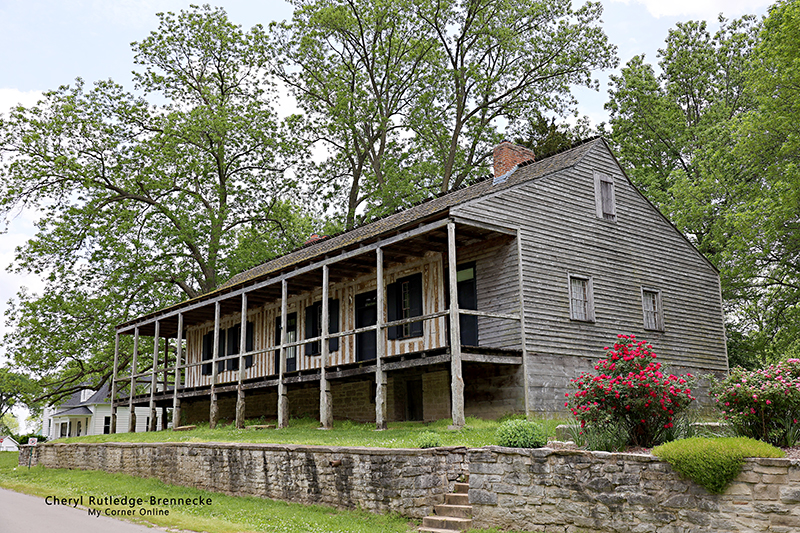
I loved the street view of the Green Tree Tavern and the gardens to the right. I am so glad that they uncovered the stone wall as it just makes the whole scene.
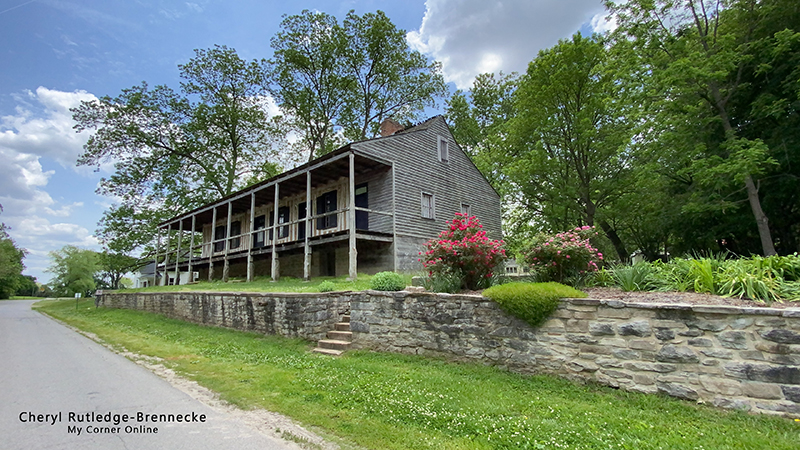
When coming from the parking area across the street, as you cross the bridge of the North Giborney Creek, you are downhill which makes the scene and perspective awesome, at least in the eye of this photographer!
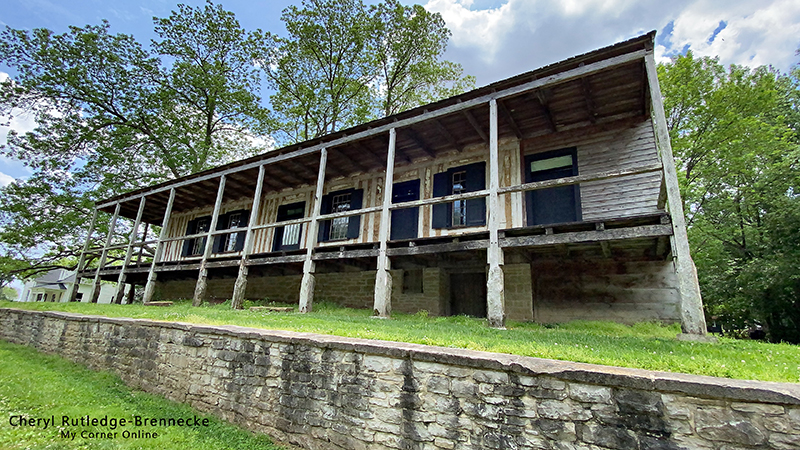
See what I mean about perspective? I love the idea of being there back in the day and being able to see what is going on under the galerie floor and imagining seeing someone coming out the doors underneath while also watching someone on the galerie either chatting or sitting down for a bite to eat.
Can you envision someone shouting out and waving you in welcome?
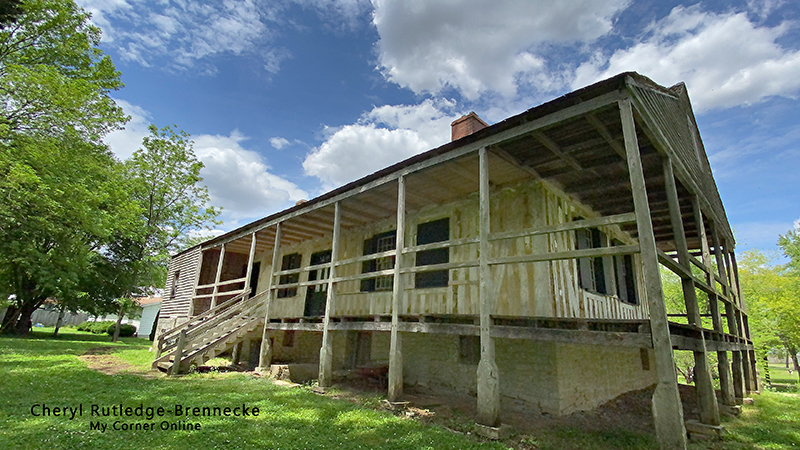
This is the view from the back. I love wrap around porches akd galerie! I wish my home had one. We have only a small porch on the front and a patio on the back.
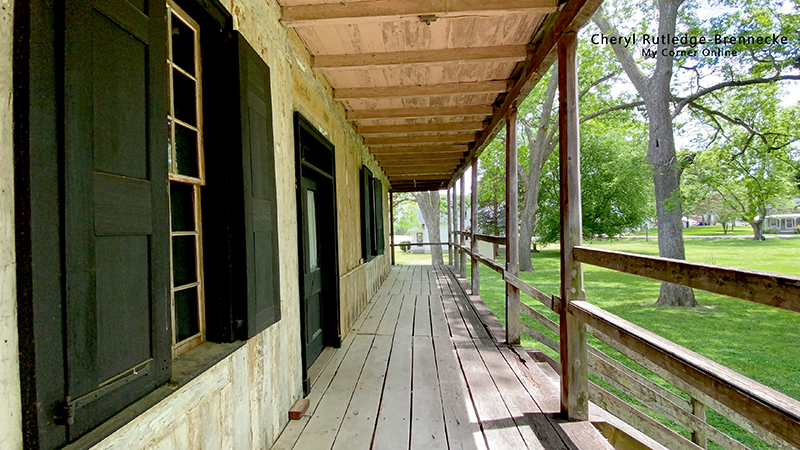
I love imagining how this would have been the scene of activity back in the day. I love the windows and peaking in. I love the textures of the wall and the wood.
Beauvais-Amoureux House
327 St Mary's Road, Ste. Genevieve, MO 63670 (3 on map) National Park Service
Built around 1792.
Hybrid of "poteaux en terre" (post in ground) and “poteau sur sole” (post on sill)
This house was built by Jean Baptiste St. Gemme Beauvais and overlooks the Le Grand Champ (the big field). Sixty years later, it was bought by Benjamin J. Amoureux in 1852. Pelagie Amoureux was born a slave of Vital St. Gemme Beauvais (son of Jean-Baptiste) in 1805. She was freed on June 11, 1832. She married Benjamin Amoureux in September 1852 in a secret marriage by a priest. The couple bought the house and had two sons, Felix and Joseph and the family stayed in the house into the 1900's. Visit Pelagie Amoureux to hear her story. This house is one of only three houses in Missouri which were owned by a free black woman before the Civil War. The Bequette-Ribault House (below) is the second. The third is in Commerce, Missouri.
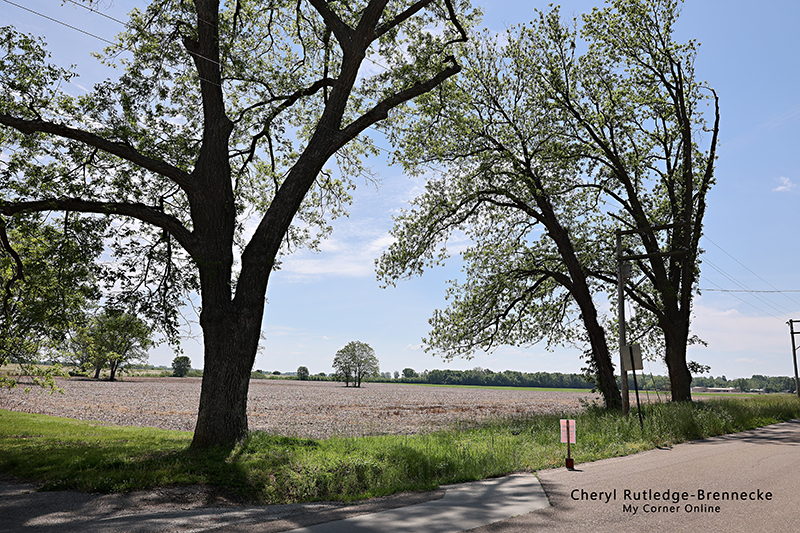
This is the big field! I was so excited to be seeing the big field aka Le Grand Champ for the first time that I think I forgot to take more photos. You have to watch the video. This is only the corner of the big field. It is so vast!
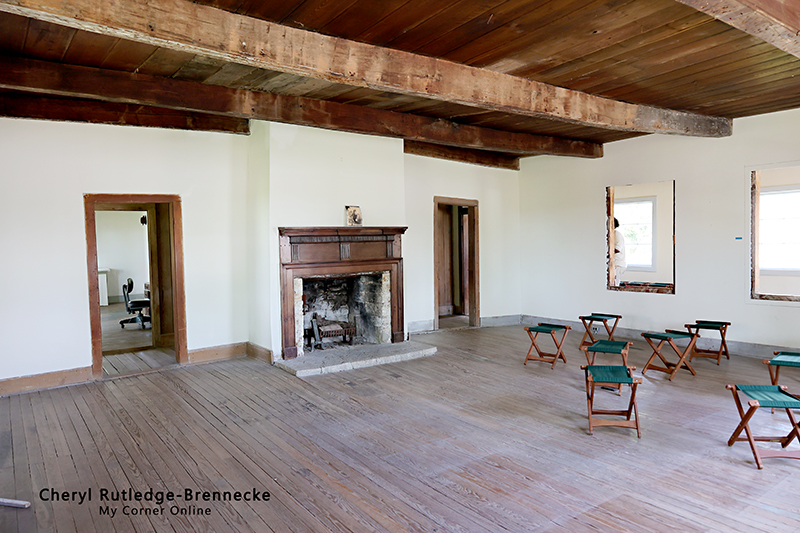
I did take a photo of the larger room in the home with the fireplace. I failed to take one of the outside.
On December 31, 1792, Charles and Madeleine Boyer deed real estate to Jean Baptiste Pratte. File 38 Boyer to Pratt. The plot is described as "a plot of an arpent wide and about an arpent long neighboring on the front to the main street of the village of the Petites Côtes Ste-Geneviève (Sainte-Geneviève little hills), at the back to Jacques Courtois, on the one side to the buyer and on the other side to a shortcut path; on which plot are built a tiny house of poteaux en terre (posts in earth), planked floors up and down, planked on the walls, and a hut for mailly (corn), as it is and as it stretches..." IThey "acquired it from Jacques Boyer."
On January 4, 1793, Charles Boyer received from François Vallé II a land grant of 1 acre in Les Petites Côtes de Ste. Geneviève (little hills of Ste. Genevieve). His land was in front of a small river and behind the land owned by the heirs of LaSource.
Jean Baptiste Valle House
99 South Main Street, Ste. Genevieve, MO 63670 (1 on map) National Park Service
This building was constructed in 1794 (although the brochure reads about 1790).
“poteau sur sole” (post on sill)
Ste. Genevieve's last commandant Jean Baptiste Valle aka J.B. Valle (1760-1849) lived in the home. Jean Baptiste is the son of François Vallé I and brother of François Vallé, II. Jean Baptiste became commandant after his brother Francois Valle II, just days before France transferred the territory to the United States in 1804. He continued his duties under the new American government for several months, thereby using the building as both the residence and government center. The next owner was leon Vion and then his granddaughter Vion Papin Schramm lived their for more than 30 years and she cultivated the wonderful garden following traditional colonial ways.
There are currently two great art collections on the walls of this building depicting buildings in Ste. Genevieve.
This house is also part of the annual garden walk and I just love the symetrical French colonial design of the garden. [Note: find those garden photos.]
Bolduc House and LeMeilleur House
Bolduc House is at 125 S. Main Street, Ste. Genevieve, MO 63670 (5 on map) Owned by French Colonial America (FCA)
Bolduc-LeMeilleur House is at 101 S. Main Street, Ste. Geneveive, MO 63670 (next door).
To tour these two buildings, you must purchased tickets around the corner at Centre for French Colonial Life, 198 Market Street, Ste. Genevieve, MO 63670. This is the starting point for the French Colonial America museum campus.
The Bolduc House was build in 1793.
The Bolduc-LeMeilleur House was built between 1815 and 1822.
“poteaux-en-terre ” (posts-in-the-earth)
Louis Bolduc contracted for the construction of this housein 1770. It is believed that Bolduc did salvage some wood from his flood damaged home in Old Ste. Gen and moved it to build this residences. It is also likely that the home was built in two separate parts, with the first part being built in 1788 and the south half in 1793. Louis Bolduc died in 1815 and the home remained in his family until 1949.
The Bolduc-LeMeilleur House was built by the son-in-law of Louis Bolduc, René and Agatha (née Bolduc) LeMeilleur. Next to this building was a brick structure built at the same time, but the lot was divided with Jean Baptiste Valle and that home now sits next door with a street in between the two houses where the old brick building used to stand. Valle bought the building and deeded it to the Sisters of Loretto in 1837 and became Our Lady of Mount Carmel, a Lorettine school. After 1848 a second story was added for the Detchmendy House Hotel. The second floor and other historical detail was destroyed in 1970.
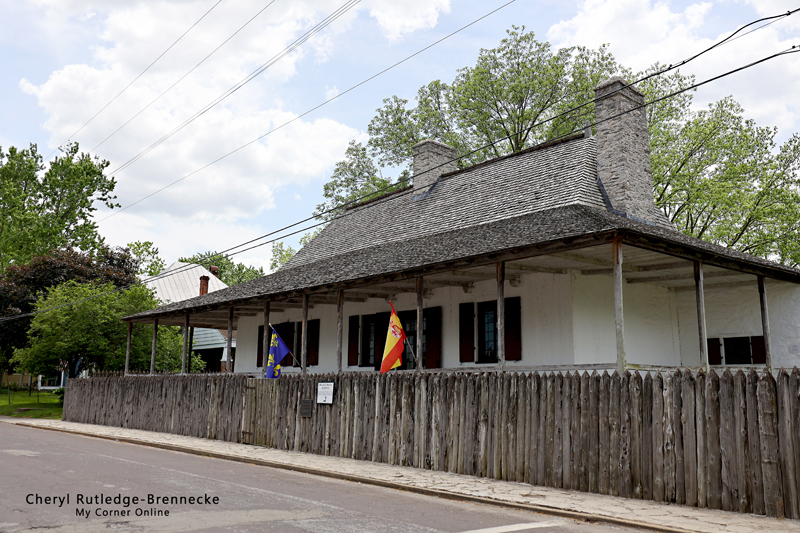
This is the front of the Bolduc House.
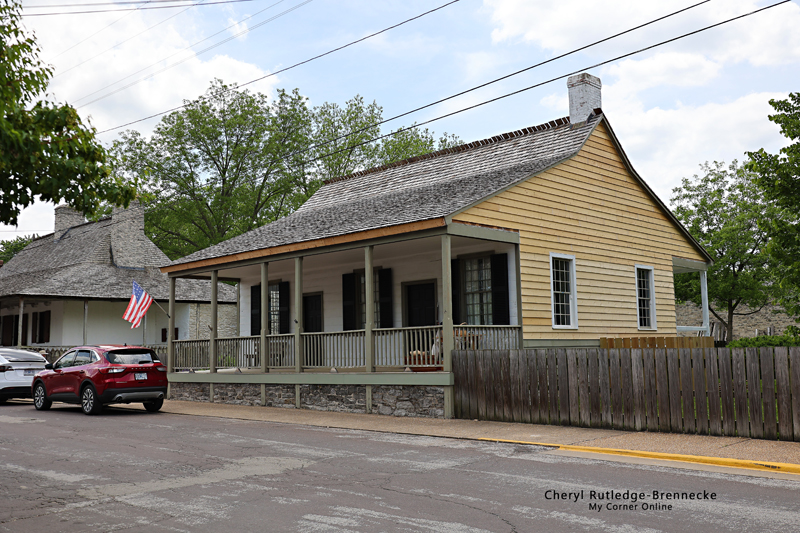
To the right of the Bolduc House is the Bolduc-LeMeilleur House.
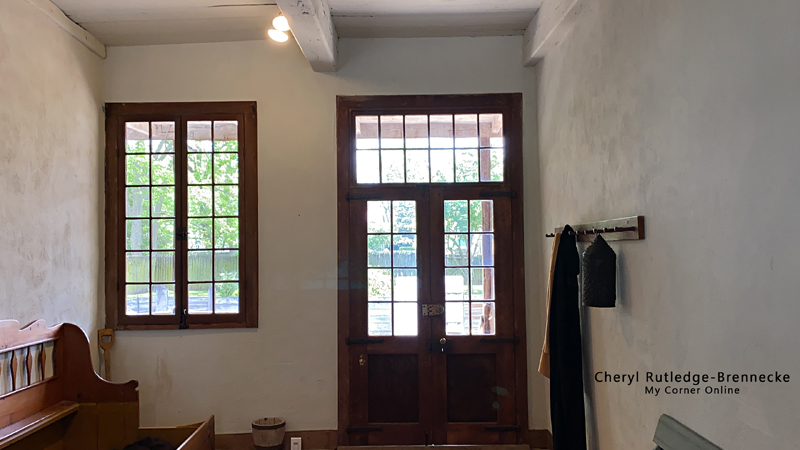
The tour begins at the back of the Bolduc House and this is the door you walk into the foyer.
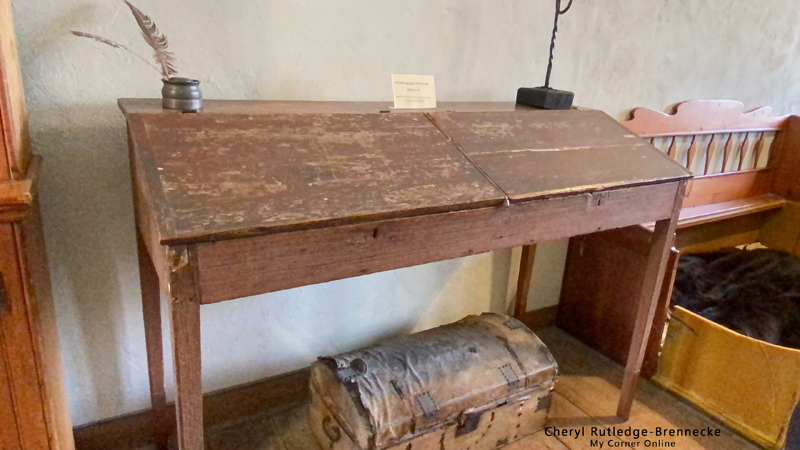
In the foyer is a desk that is thought to be original to the house.

Also in the foyer is a cut out and framed area where you can see the original structure of the wood building.
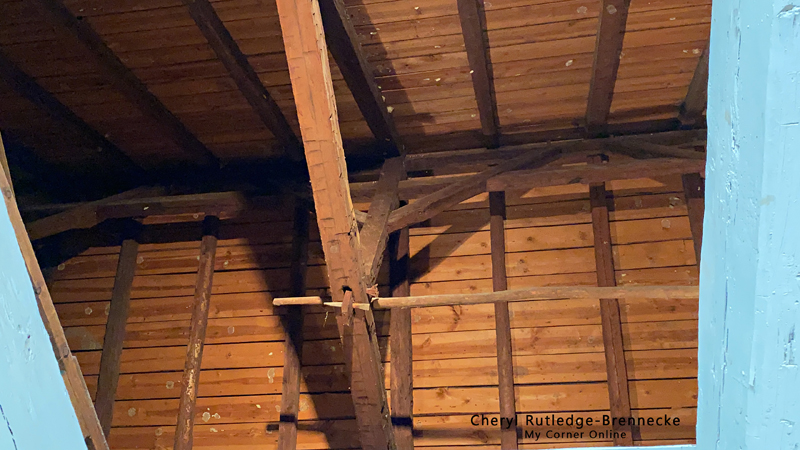
Also in the foyer is a peak at the construction of the roof and a peak into the basement as well.
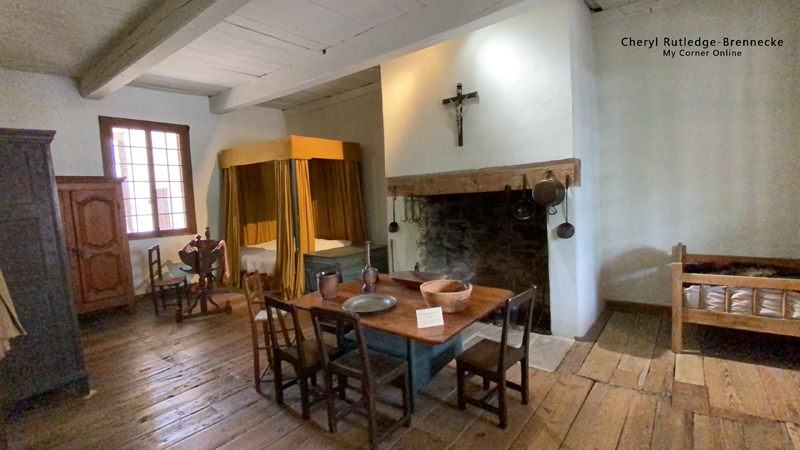
There are two rooms on either side of the foyer. This is a view of the first which is a more personal space.
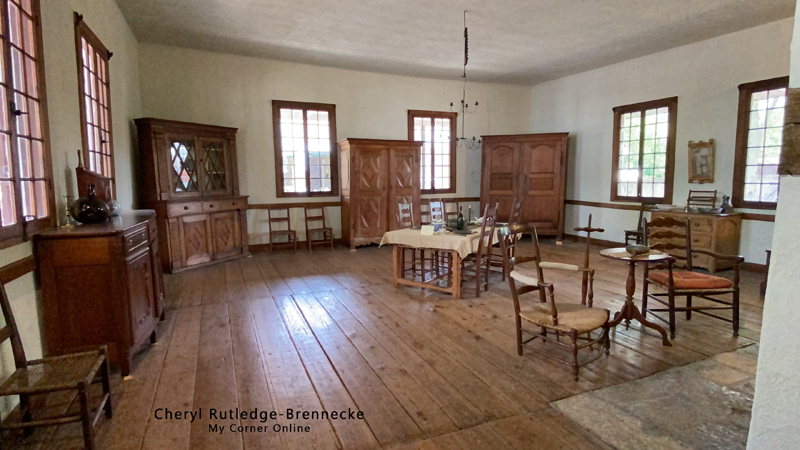
The second room is much larger and would have been for entertaining guests.
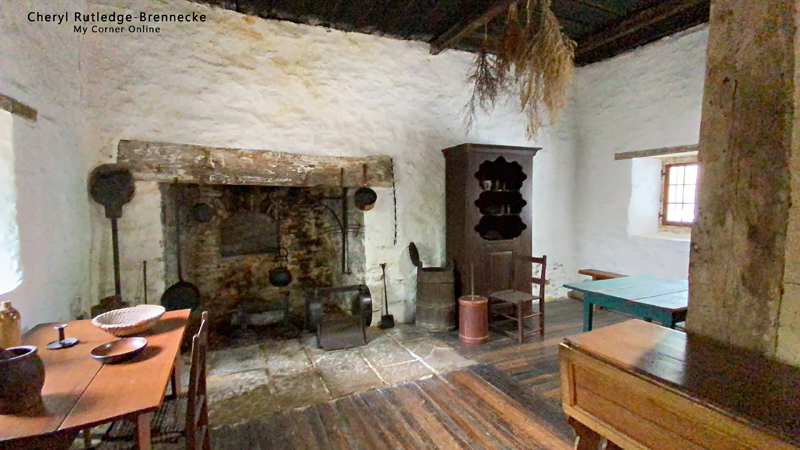
The kitchen is accessed off of the back porch.
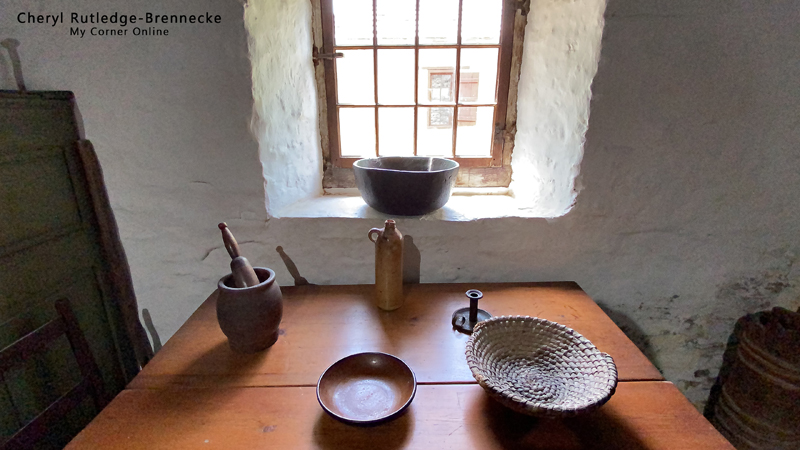
I was drawn to this view of the table overlooking the window.
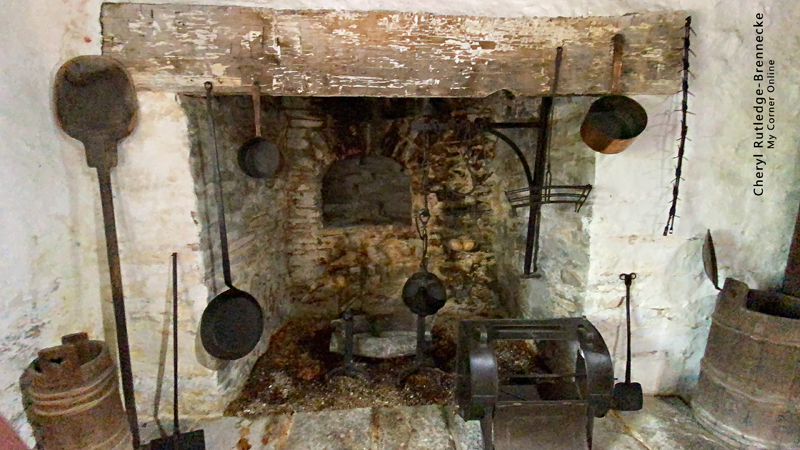
It was quite interesting to learn about the different kitchen tools that were used back in the day. You can learn about them in the video.

This is part of the first room in the Bolduc-LeMeilleur House. I was not able to take a photo of the full room for all the people touring with us standing in the room.
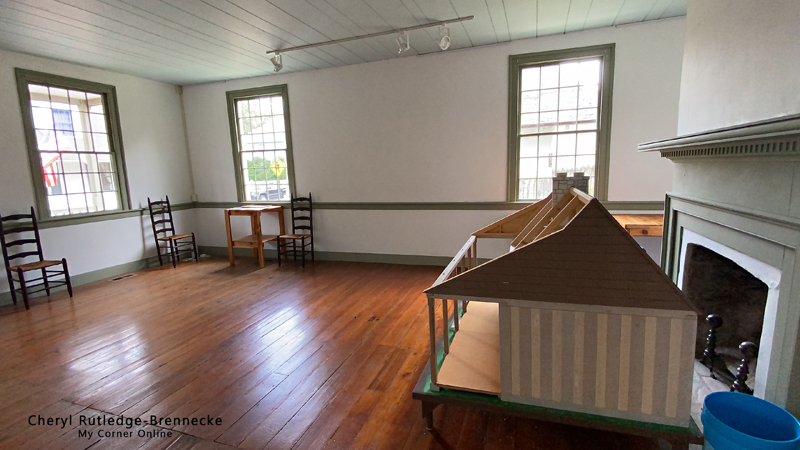
We were not allowed to go into the second room, but the door was open to peek in, so I was able to get the full size of this room.
1800's
Charles and Madeleine Boyer took up permanent residence in Old Mines around 1801. However, they would have traveled to Ste. Genevieve to sell any product of mining, farming, or hunting, as well as to pick up supplies.
Guibourd-Clovis Boyer-Jules Felix Valle House
1 North Fourth Street (corner of Fourth and Merchant Streets) Ste. Genevieve, MO 63670) owned by The Foundation for Restoration of Ste. Genevieve
Built about 1806-1807.
"poteaux en terre" (post in ground)
Jacque Guibourd is the original owner of this home and he spent time on the French colonial sugar island now known as Haiti which influenced the mix of French and ocean style home. Guibourd died in 1812, but the home stayed in his family until 1907 when Clovis Boyer made improvements on the home. Clovis was the great grandson of Jacques Boyer and Elisabeth Maurice dit Chatillon, brother of Charles Boyer and sister to his wife Marie Madeleine Maurice dit Chatillon. It was purchased by Jules Felix Valle, son of Jean Baptist Valle, in 1931. After Jules died in 1949, his wife Anne Valle traveled and filled the house with antiques. According to her wishes the house was to remain with her decorations as a memorial to its donor, Jules Felix Vallé and she died in 1971. This home allows for the only close look in the attic of the Norman truss architecture. You can see it in several other homes, but only from the floor below.

This photo is of the foyer looking through the door to the back gallerie which is now closed in.
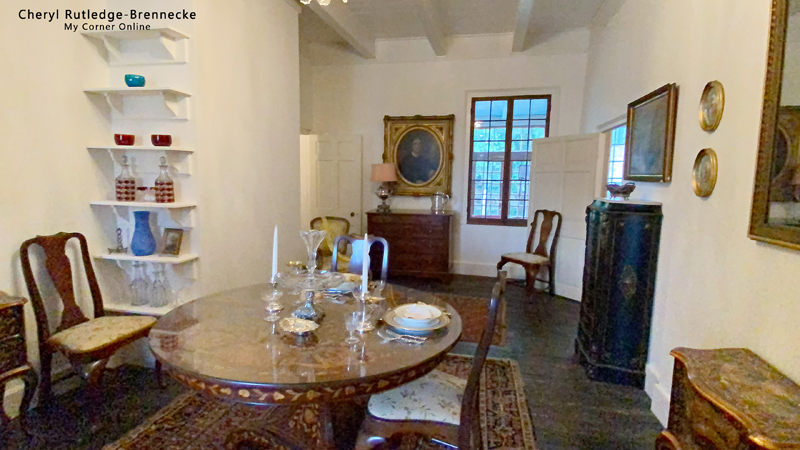
This is the middle room of the home. I did not take photos of all of the rooms, but you can see them in the video.

I absolutely love this! When Clovis Boyer built the stairs to the attic, he created as a Frenchman who tried to preserve the original without destroying it, so he took time to cut out the window in the bathroom to conform to the staircase. Prior to the staircase, a hole through the attic floor in the foyer was used to access the attic.

This just spoke to me so I had to take a photo of the ferns through the window with the lace curtains.

This is a photo of the gallerie on the back of the home, standing at the access to the attic. I would spend hours on this gallerie!

This is the attic. I love the three flags.
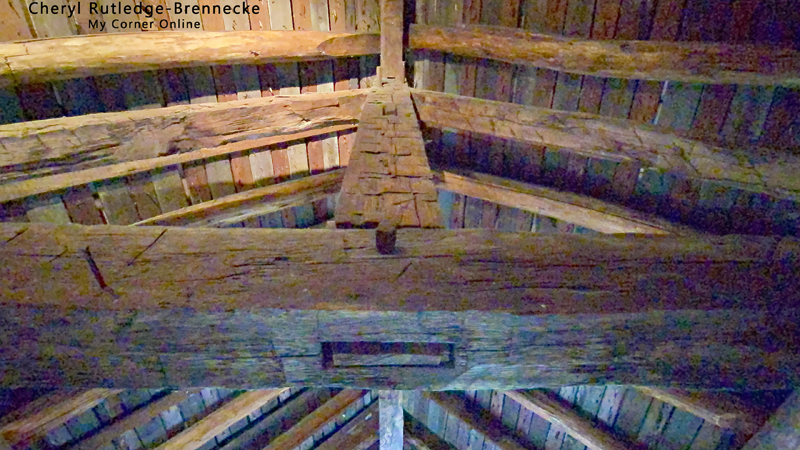
Here is a closer look at the structure of the roof.
Bequette-Ribault House and Old Ste. Genevieve
351 St Mary's Road, Ste. Genevieve, MO 63670 (4 on map) Owned by Hank and Jacque Johnson, owners of Chaumette Vineyards & Winery
Built about 1807-1808.
“poteaux-en-terre" (posts in the earth)
There has been much controversy about the date this house was built, many originally believing it was built the 1780's, which would go along the timeline of the marriage witness by Charles Boyer in 1789 as indicated above. However, dendrochronology tests in 1984 determined it was built between 1807 and 1808, about 18 years after their marriage. Jean Baptiste Bequette owned the lot in the late 1700's, but either him or his children built this house on the lot at a later date. Charles Boyer had moved to Old Mines by 1801, but living in tiff mining country, he would have traveled back to Ste. Genevieve to sell his product and being friends of the Bequettes, most likely would have visited and set foot in this home. The property was auctioned in March 1840 to Antoine Recole, a free man of color, for $405. He turned around two months later and sold it to Clarisse, a former slave of the Francois Janis household who owned the Green Tree Inn) who was a free black women from Virginia, bought the house. This house is one of only three houses in Missouri which were owned by a free black woman before the Civil War. She lived with or may have been married to John Ribault. They had two daughters and a son who continued to live in the house. The house stayed in the family until Clarisse's last grandson died in 1969.
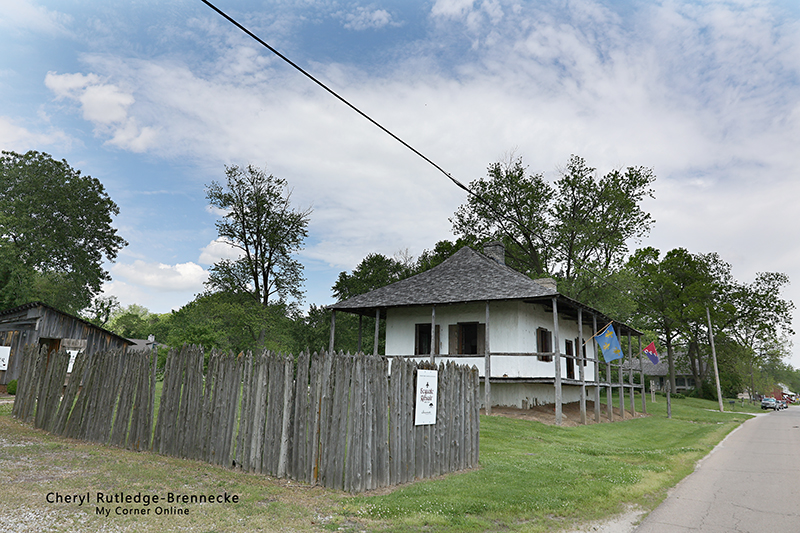
I was most excited to see this home and am glad that I took some street views of the home.
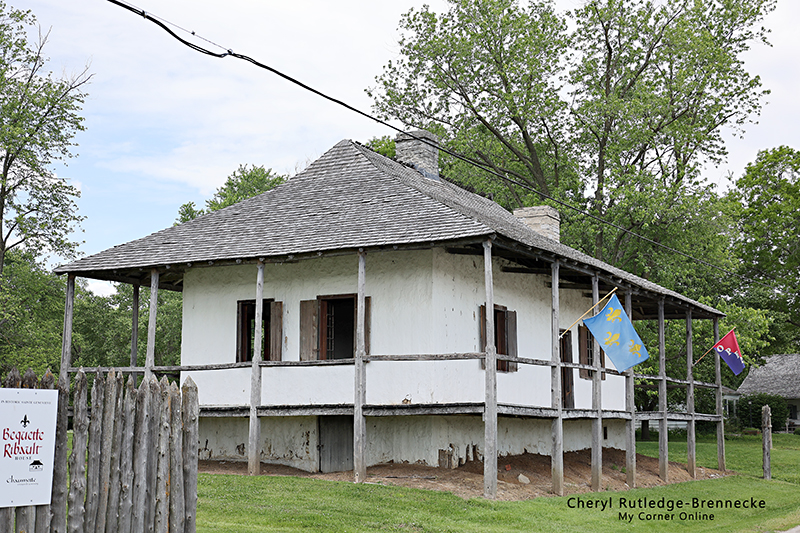
I want to pull up a chair and sit a while.
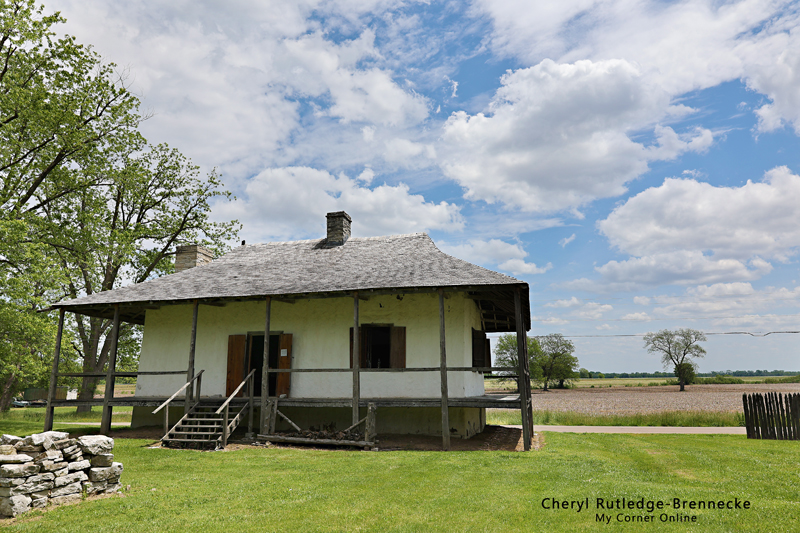
This is a view from the back of the home looking out over the big field (La Grand Champ).
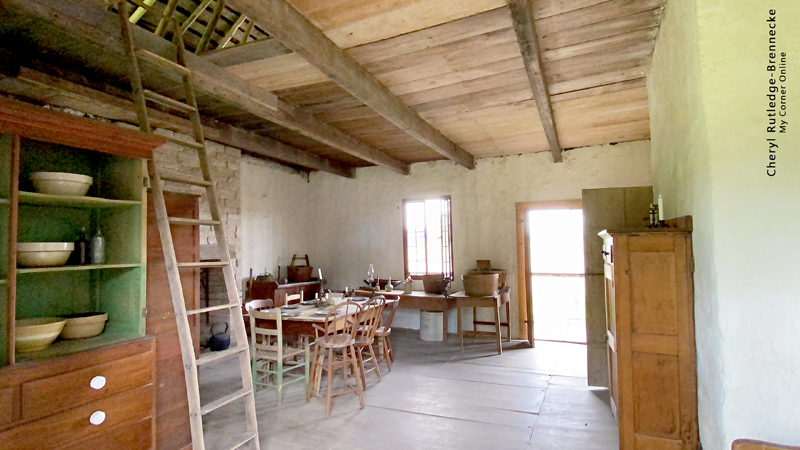
This is the view when first walking in through the back door. This is a two room home.
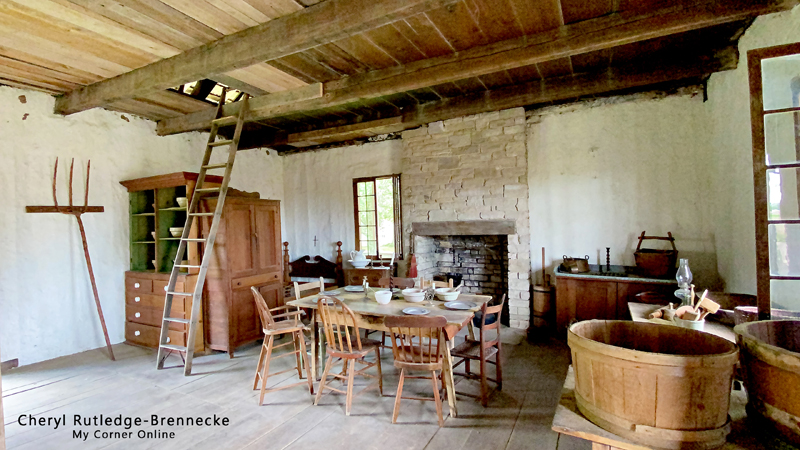
There is a ladder leading up to the attic where you can see the structure of the roof.
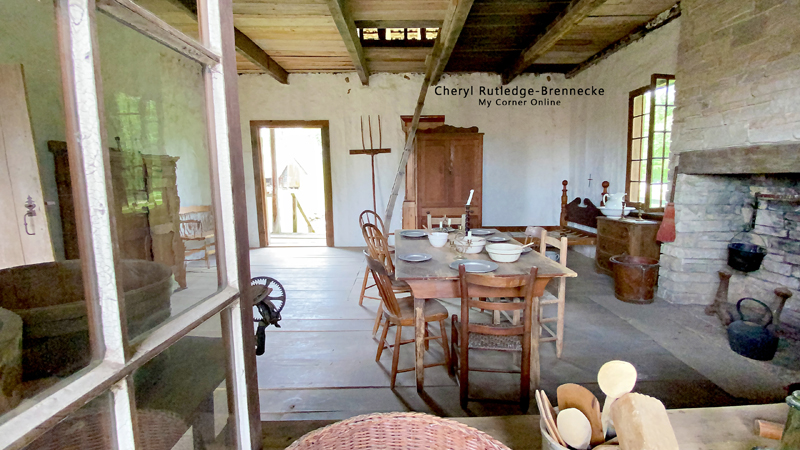
This is a view of the first room looking through the window on the front porch. I just want to shout out and ask when dinner is ready.
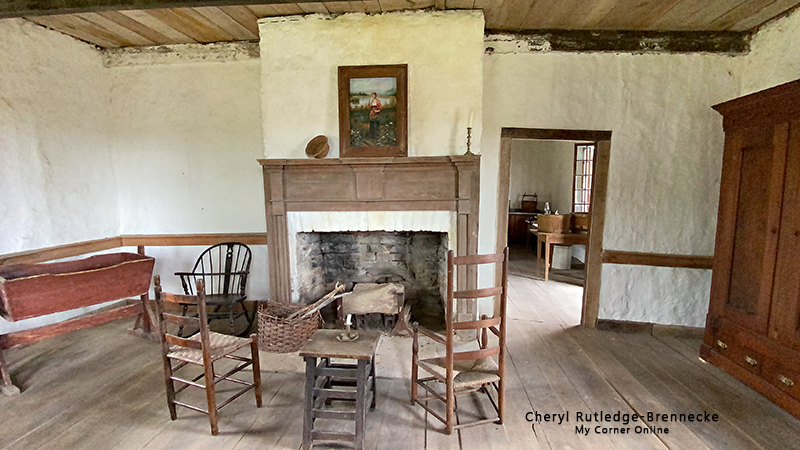
In the distance you can see the first room which has a doorway to the back and to the front porches. This is the second room.
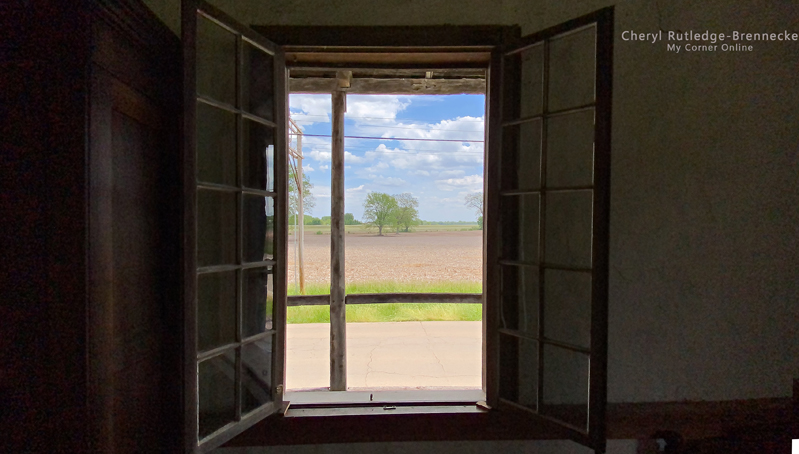
I loved the idea of being inside and looking out over the big field (La Grand Champ) and watching the crops grow or my loved ones working or them running home to eat.
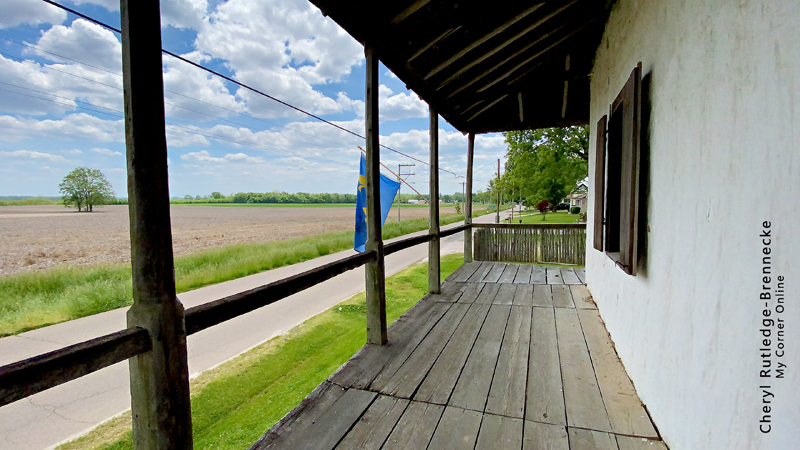
I love the "gallerie" which is what they call a wrap-around porch. I have always wanted a house with a wrap-around porch.
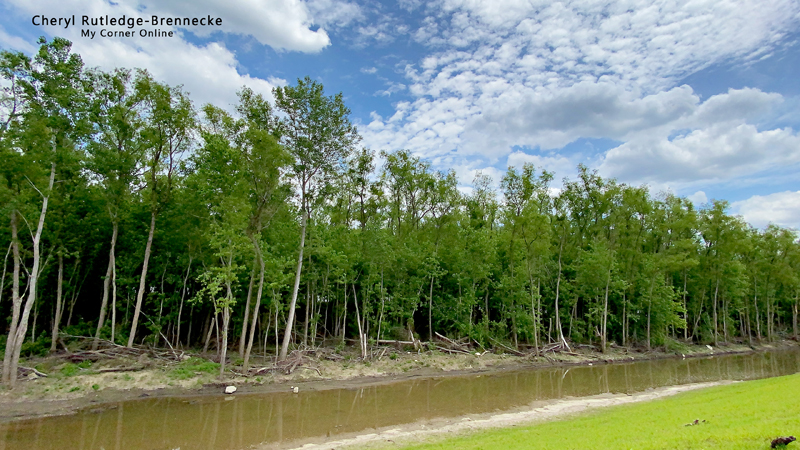
This is a view of Old Ste. Genevieve, or a rather just a small snippet of it. It is now mostly boggy and covered in Mississippi River water.

Here is another view of Old Ste. Genevieve. You can see through the trees the wide Mississippi River and there is only a small section of higher ground.
1810's
The Bolduc-LeMeilleur House was built between 1815 and 1822. (See above with Bolduc House.)
Felix Valle House and Garden
198 Merchant Street (the corner of Merchant & 2nd Streets) Ste. Genevieve, MO 63670 (6 on map) State owned and managed by the Missouri Department of Natural Resources (DNR), known at the Felix Valle State Historic Site.
Built in 1818.
This building was originally owned by Jacob Philip and sold to Jean Baptiste Valle in 1824. Incorporated in 1817, The B.L. Valle & Company firm consisted of Jean Baptiste Valle, Pierre Menard, and Jean Baptiste's son, West Pointer Louis Valle. About 1820 the name was changed to Menard & Valle. Louis died in 1833. Then it changed to Menard, Valle & Company with two new partners. When his Louis Valle died, his brother, Felix Valle took over position. After the firm dissolved, Felix and his wife Odile Pratte Valle continued to live in the building. Felix died in 1877 leaving his wife Odile as the wealthiest person in Ste. Genevieve. Odile would stand on her porch and toss dimes as the school children and it is said a dime would feed the entire family. Odile donated about 3/4ths of the cost of the Catholic church building between 1876 and 1880. The land for the Crestlawn Cemetery was also formerly owned by Odile. She died in 1881.
Charles Boyer died before 1840 in Old Mines, Washington County, Missouri, because he is not listed in the 1840 census. Marie Madeleine Boyer died November 18, 1858, in Old Mines, Washington County, Missouri. The couple would have traveled to Ste. Genevieve and back home to Old Mines.

